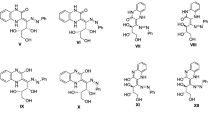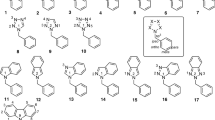Abstract
Mössbauer isomer shift /δ/ and quadrupole splitting /ΔEQ/ values in a series of isostructural compounds correlate well to give linear relationship provided the sign of electric field gradient /EFG/ is assigned to the ΔEQ. The correlation has been used in predicting the sign of EFG for some monosubstituted pentacyanoferrate/II/ complexes. Usefulness of such correlations and its limitations are presented.
Similar content being viewed by others
References
R. W. Grant, Mössbauer Effect Methodology, Ed. I. J. Gruverman, Vol. 2, Plenum Press, New York, 1966, p. 23.
Y. Hazony, R. C. Axtmann,Chem. Phys. Lett., 8 /1971/ 571.
Y. Hazony, Mössbauer Effect Methodology, Ed.: I. J. Gruverman, Vol. 7, Plenum Publ. Corp., New York, 1971, p. 147.
K. Burger,Inorg. Chim. Acta Rev., 6 /1972/ 31.
G. M. Bancroft, R. H. Platt,Adv. Inorg. Chem. Radiochem., 15 /1972/ 59.
M. G. Clark, A. G. Maddock, R. H. Platt,J. Chem. Soc., /1972/ 281.
G. M. Bancroft, Mössbauer Spectroscopy. An introduction for Inorganic Chemists and Geochemists, McGraw Hill Book Co., London, 1973, p. 116.
J. N. R. Ruddick, J. R. Sams,Chem. Phys. Lett., 28 /1974/ 548.
A. N. Garg,Radiochem. Radioanal. Lett., 22 /1975/ 157.
T. K. Sham, R. E. Watson, M. L. Perlman, Mössbauer Spectroscopy and its Chemical Applications, Ed. J. G. Stevens and G. K. Shenoy, Advances in Chemistry Series, 194, American Chemical Society, Washington DC., 1981, p. 39.
W. Kerler, E. Neuwirth, E. Fluck,Z. Phys., 175 /1963/ 200.
E. Fluck, W. Kerler, E. Neuwirth,Angew. Chem. Internat. Edn., 2 /1963/ 277.
J. Danon, L. Iannarella,J. Chem. Phys., 47 /1967/ 382.
R. W. Grant, R. M. Housley, U. Gonser,Phys. Rev., 178 /1969/ 523.
E. Fluck, P. Kuhn,Z. anorg. allg. Chem., 350 /1967/ 263.
H. E. Toma, E. Giesbrecht, J. M. Malin, E. Fluck,Inorg. Chim. Acta, 14 /1975/ 11.
A. N. Garg, P. N. Shukla,Z. Naturforsch., 36b /1981/ 59.
D. V. Parwate, A. N. Garg /unpublished data/.
P. Gütlich, Mössbauer Spectroscopy, Topics in Applied Physics, Vol. 5, Ed.: U. Gonser, Springer Verlag, New York, Heidelberg, Berlin, 1975, p. 53.
J. R. Sams, MTP International Review of Science, Phys. Chem. Ser. One, Vol. 4, Magnetic Resonance, Butterworth, London, 1972, p. 85.
C. J. Ballhausen, H. B. Gray,Inorg. Chem., 2 /1963/ 426.
H. B. Gray, Electrons and Chemical Bonding, W. A. Benjamin, Inc., New York, 1965, p. 139.
Author information
Authors and Affiliations
Rights and permissions
About this article
Cite this article
Parwate, D.V., Garg, A.N. Correlation of isomer shift and quadrupole splitting and the sign of EFG. Journal of Radioanalytical and Nuclear Chemistry Letters 87, 379–387 (1984). https://doi.org/10.1007/BF02166796
Received:
Accepted:
Issue Date:
DOI: https://doi.org/10.1007/BF02166796




